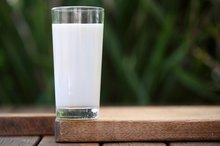What does fact checked mean?
At Healthfully, we strive to deliver objective content that is accurate and up-to-date. Our team periodically reviews articles in order to ensure content quality. The sources cited below consist of evidence from peer-reviewed journals, prominent medical organizations, academic associations, and government data.
The information contained on this site is for informational purposes only, and should not be used as a substitute for the advice of a professional health care provider. Please check with the appropriate physician regarding health questions and concerns. Although we strive to deliver accurate and up-to-date information, no guarantee to that effect is made.
Risks of Too Much Vitamin D3
Vitamin D is a fat soluble vitamin that builds and maintains your bones, according to the University of Maryland Medical Center, or UMMC. Vitamin D-3, also called cholecalciferol, is produced in the skin when exposed to sunlight, and becomes biologically active after undergoing chemical reactions in the liver to make calcidiol, followed in the kidneys to make calcitriol, according to the National Institutes of Health Office of Dietary Supplements. Too much vitamin D-3 has health risks.
Toxicity
The recommended intake of vitamin D is 200 international units, or IU, per day for adults 50 years and younger, and 400 to 600 IU for adults over 50 years of age. Vitamin D toxicity, also called hypervitaminosis D, can result when you take too much vitamin D-3 in supplemental form. Vitamin D toxicity can cause serious health problems, particularly if you suffer from heart, liver or kidney conditions. Excessive amounts of vitamin D-3 may increase blood levels of calcium, also called hypercalcemia, which in turn can cause:
- symptoms that include nausea
- vomiting
- weakness
- poor appetite
- weight loss
- constipation
- confusion
- heart rhythm abnormalities
Research by U. Querfeld published in "Pediatric Nephrology" in 2010 reports that vitamin D toxicity among children and adolescents is associated with cardiovascular complications and chronic kidney disease 2.
- The recommended intake of vitamin D is 200 international units, or IU, per day for adults 50 years and younger, and 400 to 600 IU for adults over 50 years of age.
- Vitamin D toxicity, also called hypervitaminosis D, can result when you take too much vitamin D-3 in supplemental form.
Kidney Stones
Medications That Can Raise Calcium Levels in the Blood
Learn More
Excessive vitamin D-3 in postmenopausal women may increase the risk of kidney stones. Research by Rebecca Jackson published in the "New England Journal of Medicine" in 2006 studied the effects of vitamin D-3 supplementation and calcium on the risk of hip fractures in postmenopausal women over 7 years and found that supplementation of 400 IU of vitamin D-3 and 1000 milligrams of calcium carbonate did not significantly reduce hip fractures, but did increase the risk of kidney stones by 17 percent 3.
Pancreatic Cancer
The Cleveland Clinic states that many people do not get sufficient sun exposure and require vitamin D supplementation in amounts ranging from 1,000 to 5,000 IU of vitamin D-3 per day. Furthermore, they note that you may need even higher dosages of vitamin D-3 if you suffer from celiac disease or are undergoing bariatric surgery. Yet, excess vitamin D-3 may increase the risk of cancer. Research by Rachael Stolzenberg-Solomon published in "Cancer Research" in 2006 discovered unexpectedly that higher blood concentrations of vitamin D is associated with a 300 percent increased risk for pancreatic cancer, despite the fact that the pancreas utilizes vitamin D-3.
- The Cleveland Clinic states that many people do not get sufficient sun exposure and require vitamin D supplementation in amounts ranging from 1,000 to 5,000 IU of vitamin D-3 per day.
- Research by Rachael Stolzenberg-Solomon published in "Cancer Research" in 2006 discovered unexpectedly that higher blood concentrations of vitamin D is associated with a 300 percent increased risk for pancreatic cancer, despite the fact that the pancreas utilizes vitamin D-3.
Related Articles
References
- Linus Pauling Institute: Vitamin D
- "Pediatric Nephrology"; Vitamin D Deficiency and Toxicity in Chronic Kidney Disease: In Search of the Therapeutic Window; Querfeld, U.; Dec 2010
- "New England Journal of Medicine"; Calcium Plus Vitamin D Supplementation and the Risk of Fractures; Jackson, R.D.; Feb 16 2006
- Holick MF, Gordon CM. Patient Guide to Vitamin D Deficiency. The Journal of Clinical Endocrinology & Metabolism. 2011;96(7):1-2. doi:10.1210/jcem.96.7.zeg33a
- Sunyecz JA. The use of calcium and vitamin D in the management of osteoporosis. Ther Clin Risk Manag. 2008;4(4):827-836. doi:10.2147/tcrm.s3552
- Giovannucci E, Liu Y, Hollis BW, Rimm EB. 25-hydroxyvitamin D and risk of myocardial infarction in men: a prospective study. Arch Intern Med. 2008;168(11):1174-1180. doi:10.1001/archinte.168.11.1174
- Gorham ED, Garland CF, Garland FC, et al. Optimal vitamin D status for colorectal cancer prevention: a quantitative meta analysis. Am J Prev Med. 2007;32(3):210-216. doi:10.1016/j.amepre.2006.11.004
- Lappe JM, Travers-Gustafson D, Davies KM, Recker RR, Heaney RP. Vitamin D and calcium supplementation reduces cancer risk: results of a randomized trial. The American Journal of Clinical Nutrition. 2007;85(6):1586-1591. doi:10.1093/ajcn/85.6.1586
- Prentice RL, Pettinger MB, Jackson RD, et al. Health risks and benefits from calcium and vitamin D supplementation: Women’s Health Initiative clinical trial and cohort study. Osteoporos Int. 2013;24(2):567-580. doi:10.1007/s00198-012-2224-2
- Urashima M, Segawa T, Okazaki M, Kurihara M, Wada Y, Ida H. Randomized trial of vitamin D supplementation to prevent seasonal influenza A in schoolchildren. Am J Clin Nutr. 2010;91(5):1255-1260. doi:10.3945/ajcn.2009.29094
- Salehpour A, Hosseinpanah F, Shidfar F, et al. A 12-week double-blind randomized clinical trial of vitamin D₃ supplementation on body fat mass in healthy overweight and obese women. Nutr J. 2012;11:78. doi:10.1186/1475-2891-11-78
- Carrillo AE, Flynn MG, Pinkston C, et al. Impact of vitamin D supplementation during a resistance training intervention on body composition, muscle function, and glucose tolerance in overweight and obese adults. Clin Nutr. 2013;32(3):375-381. doi:10.1016/j.clnu.2012.08.014
- Marcinowska-Suchowierska E, Kupisz-Urbańska M, Łukaszkiewicz J, Płudowski P, Jones G. Vitamin D Toxicity-A Clinical Perspective. Front Endocrinol. 2018;9:550. doi:10.3389/fendo.2018.00550
- Ross AC, Manson JE, Abrams SA, et al. The 2011 report on dietary reference intakes for calcium and vitamin D from the Institute of Medicine: what clinicians need to know. J Clin Endocrinol Metab. 2011;96(1):53-58. doi:10.1210/jc.2010-2704
- Bouillon R, Van Schoor NM, Gielen E, et al. Optimal vitamin D status: a critical analysis on the basis of evidence-based medicine. J Clin Endocrinol Metab. 2013;98(8):E1283-E1304. doi:10.1210/jc.2013-1195
- American Academy of Dermatology. Position Statement of Vitamin D. 2010.
- Taksler GB, Cutler DM, Giovannucci E, Keating NL. Vitamin D deficiency in minority populations. Public Health Nutr. 2015;18(3):379-391. doi:10.1017/S1368980014000457
- Holick MF, Binkley NC, Bischoff-Ferrari HA, et al. Evaluation, treatment, and prevention of vitamin D deficiency: an Endocrine Society clinical practice guideline. J Clin Endocrinol Metab. 2011;96(7):1911-1930. doi:10.1210/jc.2011-0385
- Cannell JJ, Vieth R, Umhau JC, et al. Epidemic Influenza and Vitamin D. Epidemiol Infect. 2006; 134:1129-40.
- Carrillo AE1, Flynn MG, Pinkston C, Markofski MM, Jiang Y, Donkin SS, Teegarden D. Impact of Vitamin D Supplementation During a Resistance Training Intervention on Body Composition, Muscle Function, and Glucose Tolerance in Overweight and Obese Adults. Clin Nutr. 2013 Jun;32(3):375-81. doi: 10.1016/j.clnu.2012.08.014. Epub 2012 Aug 31.
- Ginde AA, Mansbach JM, Camargo CA, Jr. Association Between Serum 25-Hydroxyvitamin D Level and Upper Respiratory Tract Infection in the Third National Health and Nutrition Examination Survey. Arch Intern Med. 2009; 169:384-90.
- Giovannucci E, Liu Y, Hollis BW, Rimm EB. 25-hydroxyvitamin D and Risk of Myocardial Infarction in Men: a Prospective Study. Arch Intern Med. 2008; 168:1174-80.
- Gorham ED, Garland CF, Garland FC, Grant WB, Mohr SB, Lipkin M, Newmark HL, Giovannucci E, Wei M, Holick MF. Optimal Vitamin D Status for Colorectal Cancer Prevention: a Quantitative Meta-analysis. Am J Prev Med. 2007 Mar;32(3):210-6.
- Heaney, Robert P. “The Vitamin D Requirement in Health and Disease.” The Journal of Steroid Biochemistry & Molecular Biology 97 (2005):13-9.
- Holick MF. Vitamin D. In: Shils M, Olson J, Shike M, Ross AC, ed. Modern Nutrition in Health and Disease, 9th ed. Baltimore: Williams and Wilkins, 1999.
- National Institutes of Health Office of Dietary Supplements. Vitamin D: Dietary Supplement Fact Sheet. University of Ottawa Evidence-based Practice Center. Effectiveness and Safety of Vitamin D in Relation to Bone Health. Agency for Healthcare Research and Quality. Aug 2007: 07-E013.
- Salehpour A1, Hosseinpanah F, Shidfar F, Vafa M, Razaghi M, Dehghani S, Hoshiarrad A, Gohari M. A 12-week Double-blind Randomized Clinical Trial of Vitamin D₃ Supplementation on Body Fat Mass in Healthy Overweight and Obese Women. Nutr J. 2012 Sep 22;11:78. doi: 10.1186/1475-2891-11-78.
- Urashima M, Segawa T, Okazaki M, Kurihara M, Wada Y, Ida H. Randomized Trial of Vitamin D Supplementation to Prevent Seasonal Influenza A in Schoolchildren. Am J Clin Nutr. 2010 91:1255-60. Epub 2010 Mar 10.
- Wilkins, Consuelo H. and Yvette I. Sheline, et al. “Vitamin D Deficiency Is Associated with Low Mood and Worse Cognitive Performance in Older Adults.” American Journal of Geriatric Psychiatry 14 (2006): 1032-40.
Writer Bio
Jeffrey Traister is a writer and filmmaker. For more than 25 years, he has covered nutrition and medicine for health-care companies and publishers, also producing digital video for websites, DVDs and commercials. Trained in digital filmmaking at The New School, Traister also holds a Master of Science in human nutrition and medicine from the Columbia University College of Physicians and Surgeons.








